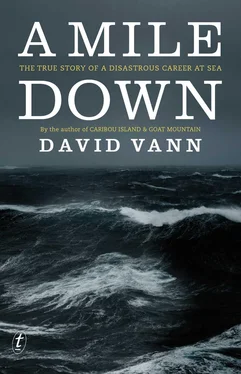So I went to work even more determined to show I deserved to be raised up. I tackled a company we had acquired. Within three weeks, and after one visit up to their offices in Seattle, I showed they had more than five hundred clients not under contract, legal notices on their website that were meaningless since they had never incorporated and weren’t a legal entity, and no protocols for who would review or execute contracts. They were also breaking the law every day by copying material from other websites and encouraging their clients to do the same. It was an intellectual property nightmare, and an extreme example of mismanagement and lack of due diligence. The general manager did not understand even the basics of business law. As I pointed out the problems to him, he had difficulty understanding, and he took no responsibility.
I reported back to the CFO and he said go get ’em. With help from our law firm, I rewrote all of the company’s contracts and legal notices and instituted due diligence. I reviewed the original acquisition of the company and followed up on licensing and stock issues. By the time I was through, I had greatly reduced our liability and put through an enormous volume of legal work while at the same time reducing our monthly legal bills from $45,000 to $8,000. In my final report, though, our president asked that I soften my exposure of the general manager’s culpability. I was basically forced to do this. Instead of telling me by e-mail, which was our usual way of operating in the company, he came down and sat with me personally. He made it clear that if I didn’t soften my exposure of negligence, I might lose my job. I gathered that some of the lack of due diligence in the original acquisition of the company might have been his own fault.
So I had to change my report, and I moved on. In addition to my work with our subsidiary, I wrote every new contract the dot-com needed for various vendors, contractors, and employees. I reviewed, revised, and negotiated contracts that came in from our largest partners, from development contracts to eBay. I substituted for in-house legal, negotiating directly even with the infamous AOL. I also wrote, reviewed, and negotiated European contracts for our new European office.
At my review, I argued again that I should be promoted to the director level and given a raise. But the CFO kept putting me off. He did this by never getting around to finishing my review. These were hard times in the dot-com world, with stock prices falling ever lower, and he needed to bring in another round of funding. He was failing at this, and all of his other duties were being put on the back burner. The truth, though, is that he didn’t stick up for me. I had a lot of inside information in that company, so I knew that a few other people were getting raises because their executives were putting in a pitch for them. At these same meetings, my boss was not putting in a pitch for me. Instead, he was just relying on me to cover more and more of his work as he focused on getting new investment.
In December, we had massive layoffs and I couldn’t help but think that many good people were losing their jobs because of mismanagement by our executives. They had paid a ludicrous amount for our subsidiary, our chief strategy officer was a nincompoop who had spent hundreds of thousands on content we weren’t even using, the general manager who should have been fired was promoted instead, and the company building our website was using kids straight out of college who billed us at more than $200 per hour. These were the excesses that brought dot-coms down. The CEO of Scient, the company building our website, was reportedly making $100 million a year. I hated seeing good people lose their jobs because of these excesses.
I kept my job because I was saving the company almost $40,000 a month in legal fees, plus doing much of the executive management team’s work and running the Product Store, and I was being paid only a little more than $5,000 per month. Our CEO pretended he was in a similar situation, since he wasn’t being paid a salary, but at the same time he was scooping up entire percentage points of stock in the company, two percent here, two percent there, striking deals influenced by his position as chairman of the board and by the fact that his wife was a partner in one of the two large venture capital firms that were funding us.
I grew to truly dislike our CEO. Usually, when things are going wrong for a large group, you can’t point the finger at just a few people, but with our CEO, president, general manager, and chief strategy officer, it was not rocket science to figure out what went wrong.
The bankruptcy court had listed the boat in Spain for seven or eight months now, but it hadn’t sold. This wasn’t a surprise, really. I had told my lenders the boat would sell only if it was fixed up, with a fresh coat of varnish and a thorough cleaning, inside and out. No one buys a boat that hasn’t been maintained. I had offered to do this work for free if they paid for flights and materials, but the lenders didn’t want to spend more money. By now, the varnish would be gone, the wood warping, the galvanized rigging rusted, and there might even be corrosion inside the hull.
In mid-November, the bankruptcy trustee made a final offer to the secured creditors, an offer which was not at all in their best interests, since the role of any bankruptcy trustee is to protect unsecured creditors (those whose loans haven’t been registered as liens against the vessel). The trustee also indicated that if the secured creditors did not agree to this plan, he might just close the case and abandon the asset back to me, the debtor. So my secured creditors asked the trustee to close the case as soon as possible. Once the boat was abandoned back to me, they would still have their liens, and the unsecured creditors would be gone.
I began work right away on a new deal with my secured creditors. In return for a much lower interest rate (the minimum federal applicable rate instead of fifteen percent) and much longer term (six years instead of three, with the first two years deferred), I would repay the full principle plus interest calculated at the new rate, and give charter time, and invest all of the money needed to put the boat back into service.
I tried not to rush into this. I tried to stop and think about what I was doing. I didn’t have to go back into business, after all. I didn’t want to wreck Nancy’s life, either. But even when I would pause and try to think, it seemed that the decision had already been made. My mind would just stop, unable to go any farther. Perhaps this was the unconscious control my father’s death still had over me. Or perhaps I would have been tied to the sea even without his death. But I also couldn’t let my private lenders take a loss. And I wanted the boat and that life back again. That life, unlike this one at the dot-com, had been self-determined. It had meant something.
My plan was to charter in the Virgin Islands and nowhere else. Once I fixed up the boat and sailed across the Atlantic I would simplify and streamline the business. No more complicated licenses and permits in various countries, no office in California, no permanent employees, and no educational charters. I would charter only through brokers, who sell the boat for a week and do all of the sales and follow-up with their clients. For the first two years I would make no payments on the loans, and for the next four years I would be paying on only $185,000 in loans at the lowest legal interest rate, since Rand and Lee had agreed, in their characteristic generosity, to have their $250,000 loan paid after the other loans, beginning in six years and ending at ten years. It was a very attractive plan, a rare second chance.
The difficult part was coming up with $100,000 to put the boat back into service. I owed $20,000 to the marina in Spain and would need to pay for legal fees, a new insurance policy, a new paint job, new standing rigging, new varnish, equipment overhauls, a new dinghy and outboard, etc. It was a solid hull, made of the highest-grade steel and only two years old, but all the cosmetics would have to be redone. The dot-com had promised a bonus, and I needed to make sure I received it. I also needed to sell Grendel . Nancy and I began working on Grendel immediately, at the end of November, to have it ready for sale when the bankruptcy trustee officially closed my case. Nancy would also take out credit cards to help fund the new business.
Читать дальше












